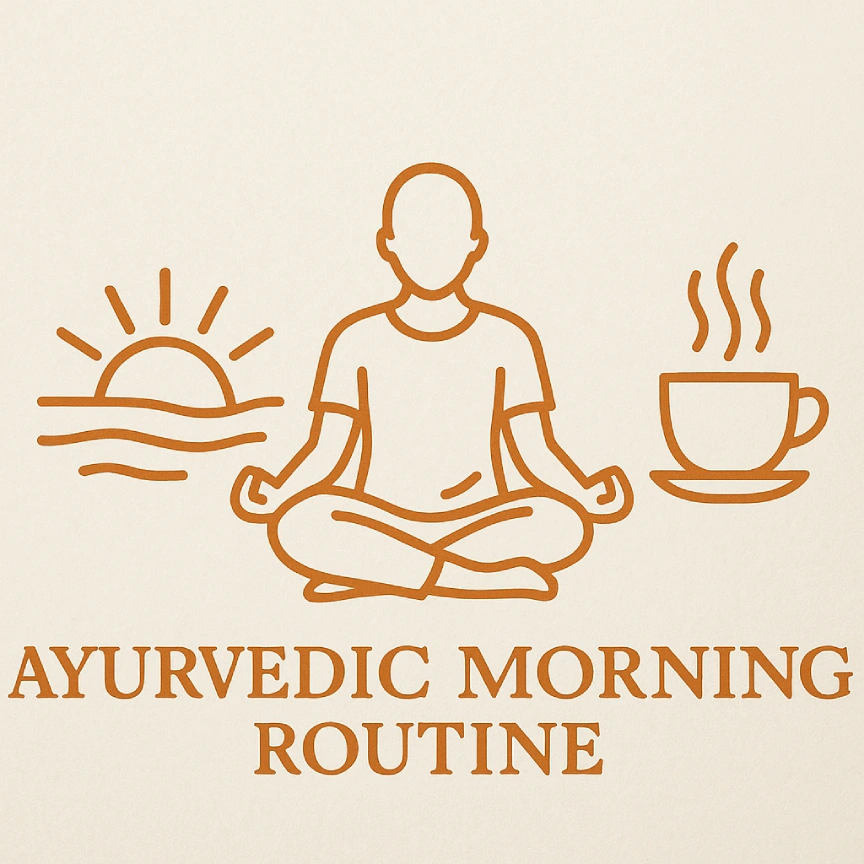A steady Ayurvedic night routine helps calm the senses, support Agni (digestive fire), reduce Ama (toxins), and build Ojas (vitality and resilience) for the day ahead. Classical texts (e.g., Ashtanga Hridayam, Charaka Samhita) emphasize gentle oiling, light food, and mental quiet in the evening. Below is a practical, modern guide grounded in tradition—with options by Dosha, season, and lifestyle.
Why Evenings Matter in Ayurveda
6–10 p.m. (Kapha Time)
Nature is heavier and slower—ideal for winding down and falling asleep.
10 p.m.–2 a.m. (Pitta Time)
Metabolic repair and liver "housekeeping" intensify. Being asleep by ~10 p.m. supports this process.
Goal: Finish dinner early, quiet the senses, be in bed before 10 p.m.
The Core Routine (30–60 minutes)
1) Close the Day Gently (5 min)
- Diminish overhead lights; use warm, low lighting.
- Park worries: write a 3-line "tomorrow list."
- Avoid stimulating topics, news, and intense work.
2) Light, Early Dinner (finish 3–4 hours before bed)
Favor warm, simple meals: khichdi, moong dal soup, lightly spiced vegetables, soft grains.
Avoid: Heavy, raw, fried, or very spicy meals at night. Alcohol and desserts can disturb sleep quality.
3) Short Stroll + Light Tidy (10–15 min)
- A relaxed walk aids digestion (no vigorous exercise at night).
- Quick kitchen tidy signals closure to the day.
4) Warm Bath or Shower (optional, 5–10 min)
Comfortably warm water relaxes muscles and settles Vata.
Keep it brief; avoid very hot showers that aggravate Pitta.
5) Targeted Oiling to Calm the Nervous System (5–10 min)
Padabhyanga (oil foot massage): 1–2 tsp warm oil to feet and ankles; wipe excess or wear cotton socks.
Shiroabhyanga (scalp/temple massage): A few drops oil to temples/ears/scalp; gentle circles.
Oils by Dosha:
- Vata: Sesame oil
- Pitta: Coconut or ghee
- Kapha: Sesame with a pinch of stimulating oil (e.g., mustard blend)
Nasya: 2–3 drops "pratimarsha" in each nostril is traditionally safe daily; many reserve fuller nasya for mornings. At night, consider only if dryness or snoring is an issue. Avoid during congestion, active infection, pregnancy, or soon after meals.
6) Breath, Mantra, or Prayer (5–10 min)
- Nadi Shodhana (alternate-nostril breathing) 6–12 rounds; or Bhramari (humming breath).
- Silent mantra, gratitude, or brief meditation to release the day.
7) In-Bed Cues (5 min)
- Dark, cool, and quiet room; remove devices.
- A simple sensory anchor: a few drops lavender or sandalwood on a tissue near the pillow.
- Target lights-out: around 10:00 p.m.
Dosha-Specific Tweaks
Vata (light, cool, mobile)
Dinner: Heartier soups, root vegetables, ghee.
Oiling: Sesame or Vata-specific oils; longer foot/scalp massage.
Bedtime drink: Warm milk (dairy or almond) with cardamom, a pinch of nutmeg.
Extras: Weighted blanket or extra layer; consistent schedule is essential.
Pitta (hot, sharp)
Dinner: Cooling/wet foods—zucchini, asparagus, basmati rice; avoid chilies, vinegar, alcohol.
Oiling: Cooling oils (coconut/ghee).
Cooling the mind: Journaling gratitude, moonlight or dim, cool room; avoid arguments or late-night work.
Bedtime drink: Warm milk with cardamom and rose water (a few drops).
Kapha (heavy, slow)
Dinner: Lightest of the three—soups, steamed veg, legumes well-spiced (ginger, black pepper).
Movement: A brisker early-evening walk is helpful; avoid napping.
Oiling: Minimal—focus on feet only, or use lighter oils.
Stimulus control: Keep room slightly warmer and very uncluttered; consider gentle, uplifting breath (3–5 slow, brighter breaths—no intense pranayama).
Seasonal Notes (Ritucharya)
Adapting your evening routine to the seasons helps maintain balance year-round. Learn more about Ritucharya: The Ayurvedic Art of Seasonal Living.
- Autumn/Winter (Vata seasons): More warmth, oiling, and moist foods; earlier bedtime.
- Summer (Pitta): Emphasize cooling routines and milk with cardamom/rose; keep room cool and dark.
- Spring (Kapha): Light dinners, spice teas (ginger–cinnamon), reduce oiling time.
Gentle Evening Beverages (choose one)
Dosha-Specific Bedtime Drinks:
- Vata/Pitta: Golden milk (turmeric pinch + cardamom; sweeten lightly).
- Kapha: Ginger–tulsi tea or cumin–coriander–fennel tea.
- Triphala tea: ½ tsp powder steeped 10–15 min, 1–2 hours after dinner for bowel regularity. Avoid in pregnancy, diarrhea, or if on certain medications; check with a practitioner.
Bedroom Setup (Sattvic Sleep Environment)
Darkness
Blackout curtains or sleep mask.
Temperature
Slightly cool for most; warmer for Vata.
Clarity
Minimal clutter; remove work items and bright LEDs.
Scent
Lavender, jatamansi, or vetiver (subtle).
What to Avoid at Night
- Heavy meals, desserts, or alcohol
- Intense exercise or heated debates
- Bright screens in the last hour (blue light delays melatonin)
- Stimulating pranayama (e.g., Kapalabhati, Bhastrika)
One-Page Checklist
Your Evening Dinacharya Checklist
- Eat light, warm dinner by ~6–7 p.m.
- 10–15 min gentle walk
- Warm rinse; padabhyanga + brief scalp/temple oiling
- 6–12 rounds Nadi Shodhana or 5 min Bhramari
- Optional herbal milk/tea suited to your Dosha
- Lights low, devices out; in bed by 10 p.m.
Frequently Asked Questions
Safety & Medical Note
This guide is educational and not a substitute for medical care. If you have a sleep disorder, are pregnant, nursing, or on medications (including sedatives, SSRIs, or blood thinners), consult your clinician and an Ayurvedic practitioner before adding herbs or new practices.
References
- Ashtanga Hridayam, Sutra Sthana
- Charaka Samhita, Viman Sthana
- Classical Dinacharya Texts
- Traditional Ayurvedic Sleep Practices
Related Articles

Ayurvedic Morning Routine: A Grounding Start to Your Day (Dinacharya)
Master the ancient practice of Dinacharya with this comprehensive Ayurvedic morning routine guide. Learn essential practices from tongue scraping to Abhyanga that strengthen Agni, clear Ama, and build Ojas.
12 min read min read
Best Ayurvedic Spices for Immunity, Digestion & Sleep
Discover the best Ayurvedic spices for boosting immunity, supporting digestion, and enhancing sleep. Learn practical uses for turmeric, cumin, ginger, and more to incorporate ancient wellness into modern life.
8 min read min read
